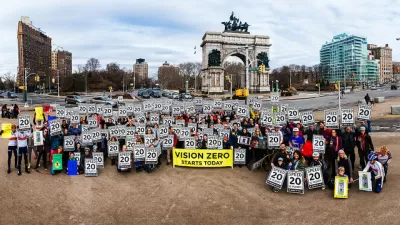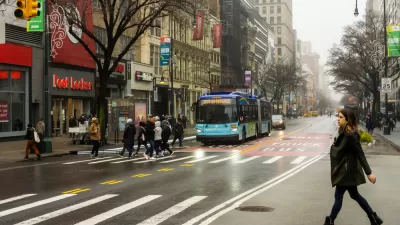Vision Zero has tragically failed 17 people on bikes in New York City this year, and Mayor Bill de Blasio couldn't stick with the status quo any longer.

A spate of cyclist fatalities in New York City inspired city officials to announce a large new bike infrastructure and traffic safety program whit week, reports Willie Hu.
The tragedies leading up to the announcement need to be respected. Hu starts the story of thusly:
Things could not get much worse in early July after three cyclists were killed in just over a week on the streets of New York City.
But they did. Two more cyclists were hit and killed on Tuesday — one in Brooklyn and another on Staten Island — and another struck on Wednesday morning in Queens was reportedly in critical condition.
That brings the year's total to 17—already seven more deaths than 2018. In response to growing pressure from advocates, Mayor Bill de Blasio, also a candidate for president, announced a $58.4 million bike safety plan, called the Green Wave [pdf]. The Green Wave plan "will try to make cycling safer by rapidly installing more protected bike lanes, redesigning intersections to make turns safer for cyclists and hiring 80 new city transportation workers dedicated to bike improvements," writes Hu.
"Under the new plan, the city will increasingly focus on creating a citywide network of protected bike lanes; currently the city has 1,243 miles of bike lanes, of which 480 miles are protected, meaning barriers physically separate cyclists from vehicles," adds Hu.
Earlier in the year, a single death by a cyclist on a rented bike in San Francisco inspired that city to remove on-street parking and create a protected bike lane on Howard Street. Perhaps every city has its limits. More coverage on New York's Green Wave plan is available in a separate article by Amanda Luz Henning Santiago.
FULL STORY: After 17 Cyclists Die, New York City Makes $58.4 Million Plan

Planetizen Federal Action Tracker
A weekly monitor of how Trump’s orders and actions are impacting planners and planning in America.

Restaurant Patios Were a Pandemic Win — Why Were They so Hard to Keep?
Social distancing requirements and changes in travel patterns prompted cities to pilot new uses for street and sidewalk space. Then it got complicated.

Map: Where Senate Republicans Want to Sell Your Public Lands
For public land advocates, the Senate Republicans’ proposal to sell millions of acres of public land in the West is “the biggest fight of their careers.”

Maui's Vacation Rental Debate Turns Ugly
Verbal attacks, misinformation campaigns and fistfights plague a high-stakes debate to convert thousands of vacation rentals into long-term housing.

San Francisco Suspends Traffic Calming Amidst Record Deaths
Citing “a challenging fiscal landscape,” the city will cease the program on the heels of 42 traffic deaths, including 24 pedestrians.

California Homeless Arrests, Citations Spike After Ruling
An investigation reveals that anti-homeless actions increased up to 500% after Grants Pass v. Johnson — even in cities claiming no policy change.
Urban Design for Planners 1: Software Tools
This six-course series explores essential urban design concepts using open source software and equips planners with the tools they need to participate fully in the urban design process.
Planning for Universal Design
Learn the tools for implementing Universal Design in planning regulations.
Heyer Gruel & Associates PA
JM Goldson LLC
Custer County Colorado
City of Camden Redevelopment Agency
City of Astoria
Transportation Research & Education Center (TREC) at Portland State University
Camden Redevelopment Agency
City of Claremont
Municipality of Princeton (NJ)





























